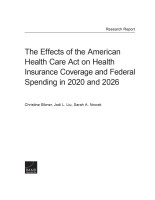| 来源类型 | Research Reports
|
| 规范类型 | 报告
|
| DOI | https://doi.org/10.7249/RR2003
|
| 来源ID | RR-2003-CMF
|
| The Effects of the American Health Care Act on Health Insurance Coverage and Federal Spending in 2020 and 2026 |
| Christine Eibner; Jodi L. Liu; Sarah A. Nowak
|
| 发表日期 | 2017
|
| 出版年 | 2017
|
| 页码 | 42
|
| 语种 | 英语
|
| 结论 |
Health Insurance Enrollment Would Have Decreased- The authors estimate that the American Health Care Act (AHCA) would have reduced health insurance enrollment by 14.2 million people in 2020; the loss of health insurance would have increased to 19.7 million people by 2026.
- The AHCA would have increased the federal deficit by $38 billion in 2020 while reducing the deficit by $5 billion in 2026.
Older Individuals, Poorer Individuals, and Those with Worse Self-Reported Health Would Have Been Disproportionately Affected by the AHCA- Most adults ages 50 to 64 and most people with incomes under 200 percent of the federal poverty level (FPL) would have paid more for individual-market insurance under the AHCA than under current law. The higher costs for older adults partly reflect that the AHCA's tax credits did not increase as steeply with age as premiums did.
- In 2020, the number of uninsured individuals age 50 to 64 would have been 119 percent larger under the AHCA than under the ACA, compared with a 42-percent increase for those under age 50.
- The authors estimated an 80-percent increase in the number of uninsured people with incomes at or below 200 percent of the FPL under the AHCA, compared with a 15-percent increase in the number of uninsured people with incomes above 200 percent of the FPL.
- The authors also found a 99-percent increase in the number of uninsured individuals in poor or fair self-reported health; this finding reflects that sicker people are more likely than healthy people to be older and poorer and are thus more likely to lose access to Medicaid or face high premiums in the individual market.
|
| 摘要 |
- To retain current insurance enrollment levels without increasing the federal deficit, one possible solution would be to better target tax credits based on enrollees' needs — for example, by increasing the amount of funding available for lower-income individuals. In theory, such an approach could lead people to forgo employment opportunities or reduce their hours worked to retain eligibility for tax credits. However, evidence to date shows no such effects stemming from the ACA's coverage expansions.
- In addition, policymakers might consider higher tax credits for older adults to address the concern that premiums increase more steeply than credit amounts.
|
| 主题 | Affordable Care Act
; Health Care Costs
; Health Care Reform
; Health Insurance Benefit Design
; United States
|
| URL | https://www.rand.org/pubs/research_reports/RR2003.html
|
| 来源智库 | RAND Corporation (United States)
|
| 引用统计 |
|
| 资源类型 | 智库出版物
|
| 条目标识符 | http://119.78.100.153/handle/2XGU8XDN/108470
|
推荐引用方式
GB/T 7714 |
Christine Eibner,Jodi L. Liu,Sarah A. Nowak. The Effects of the American Health Care Act on Health Insurance Coverage and Federal Spending in 2020 and 2026. 2017.
|
|
文件名:
|
x1495297809673.jpg
|
|
格式:
|
JPEG
|

|
文件名:
|
RAND_RR2003.pdf
|
|
格式:
|
Adobe PDF
|
除非特别说明,本系统中所有内容都受版权保护,并保留所有权利。